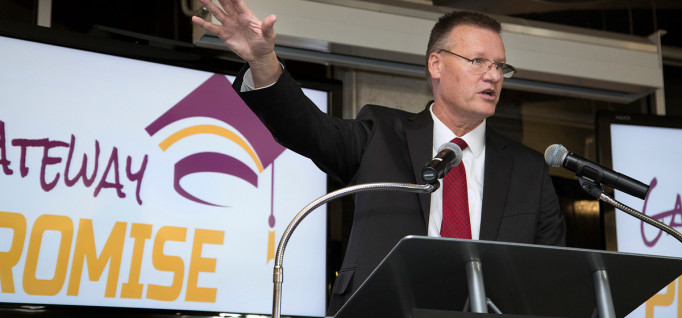Making a Greater Promise
By AACC Staff
February 29, 2016
Learn more about the next institution to offer free community college and how it is preparing students.
This article, by Ellie Ashford, originally appeared in the Community College Daily.
Gateway Technical College (GTC) in Wisconsin may be the new poster child for the free community college movement.
On Thursday, the college announced that SC Johnson — the maker of consumer products such as Windex, Ziploc and Raid, among others — would donate $300,000 to its new Gateway Promise program, a new initiative to benefit local, low-income high school seniors. Fisk Johnson, the company’s CEO and board chair, is donating an addition $400,000 on his own.
“We’re proud to support a program that will enable people to affect change and chart a new direction in their lives,” he said in a press release. “A quality education is critical to the success of our youth and our community.”
Such partnerships that bring together colleges, business and industry, communities and even state support are what free community college backers hope will continue — if not increase — momentum in the movement to make college affordable for qualifying students.
How to make a Promise
The Gateway Promise program will fill the gap between a student’s financial aid grants and the cost of attending GTC, including tuition and fees, for three years, starting with the fall 2017 semester. The eligible students must graduate on time and maintain a GPA of at least 2.0 by the end of 11th grade. Students who meet certain requirements will be automatically re-enrolled in the Gateway Promise.
The program is funded by donations, mostly from corporations, to the college’s foundation. GTC had decided it wouldn’t launch the program until the foundation had raised $1 million for its Gateway Promise Endowment Fund. It already has $1.5 million, said spokesperson Jayne Herring, and the new goal is $3 million, which would make the program permanent.
Students receiving Gateway Promise scholarships will be required to participate in at least one extracurricular activity, such as community service, a student club or an international program.
A key element of the program is a free, mandatory summer bridge program, where students will learn about college activities and academic support and participate in career planning workshops. To prepare students for college, GTC has assigned “new student specialists” to local high schools to help students develop a postsecondary plan, provide advice on careers and enroll in college.
GTC has multiple reasons for launching the Promise program. “We want to ensure all high school students have an opportunity to continue into college and be successful there,” Herring said. “We’re also hoping to fulfill the need for employers for a skilled workforce.”
The college expects its completion rate will increase, as well as the number of students who enroll immediately after high school. Currently, only 11 percent of GTC registrants are direct high school graduates, Herring said. College officials hope the Promise program will increase that to 40 percent within the next few years. According to GTC, high school students who enroll in college immediately after high school are three times more likely to earn a degree than those who delay higher education.
The 13th year
While Gateway Promise emulates recent efforts to make community college more affordable, several colleges and states have been offering slightly different versions for a few years.
The 13th Year Promise Scholarship program offered by South Seattle College (SSC) in Washington provides free tuition for the first year of college to any student at an eligible high school who completes a financial aid application. Students must enroll immediately after graduation.
During a retreat several years ago, the college foundation board was looking at the higher education landscape, and one data point stood out — the “tipping point” concept that highlighted the importance of one year of college, says Elizabeth Pluhta, associate vice president of college readiness and advancement.
Research showed that people who completed just one year of college are more likely to get a good job, continue in college and become engaged citizens. It also found that students’ finances are the No. 1 barrier keeping them out of college, Pluhta said.
SSC started the 13th Year Promise Scholarships in 2008 for students at Cleveland High School, one of its four feeder high schools. Two other high schools were subsequently added, and the fourth, West Seattle High School, will be added when the program is fully funded.
The program is entirely privately funded through the college’s foundation. According to Pluhta, it costs about $500,000 a year, including a readiness academy and extra support for students, as well as the scholarships. Normally, tuition runs about $4,000 a year for full-time students.
There are no GPA limits for students, and many who applied had never planned on college so they weren’t prepared. “We found we needed to do more work to ensure they succeed in college,” Pluhta said, so the program was tweaked in 2011 to require students to participle in a readiness academy in their senior year of high school.
The academy comprises a series of workshops to help students understand what college is all about. It’s like “College 101,” she says. “We saw this as a key piece of our strategy.” The Readiness Academy is open to everybody in the school, not just those planning to take advantage of the 13th year program. “We are really clear,” Pluhta says. “Everybody deserves to go to college and get to that tipping point.”
If students test below grade level on a placement test, they come to the campus for four Saturday sessions in the spring for intensive math or English remediation taught by SSC faculty.
To continue reading this article, visit Community College Daily.






